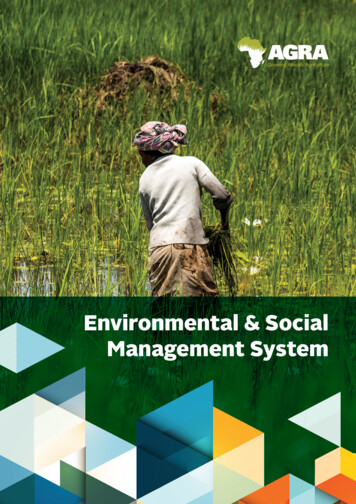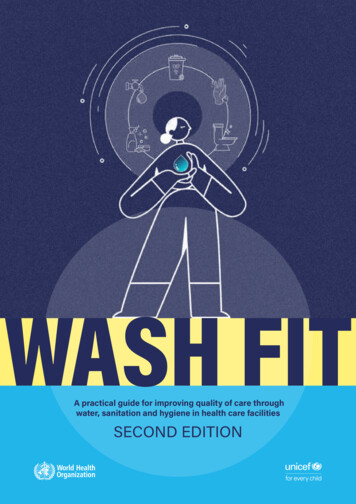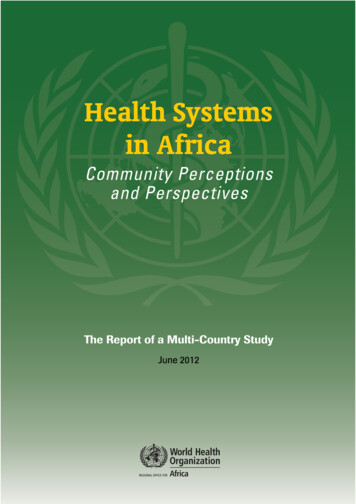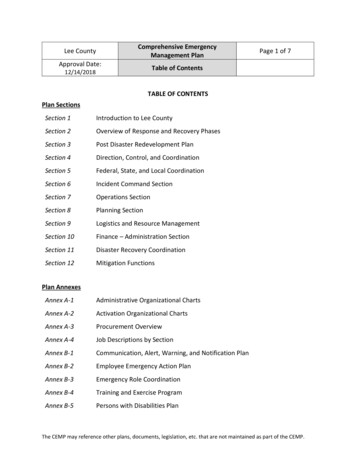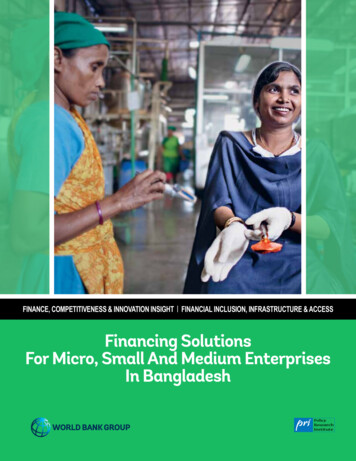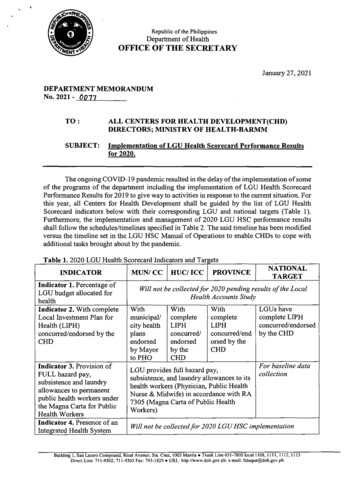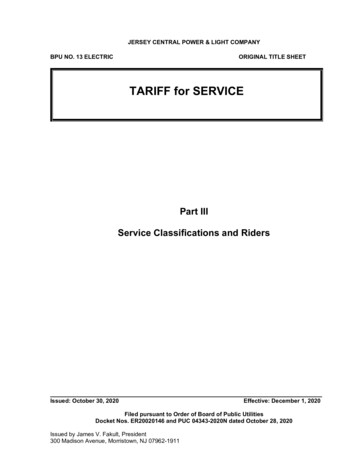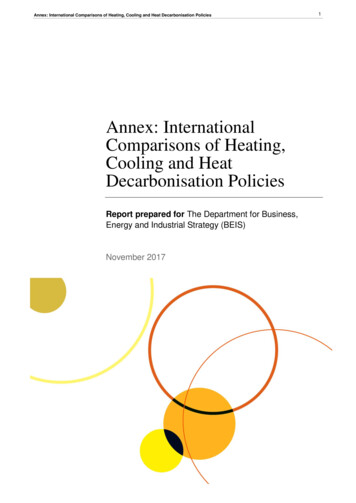
Transcription
Annex: International Comparisons of Heating, Cooling and Heat Decarbonisation PoliciesAnnex: InternationalComparisons of Heating,Cooling and HeatDecarbonisation PoliciesReport prepared for The Department for Business,Energy and Industrial Strategy (BEIS)November 20171
Annex: International Comparisons of Heating, Cooling and Heat Decarbonisation Policies2ContentsAnnex 1: Methodology . 3Annex 2: Country-level summaries . 16Annex 3: Detailed case studies . 27
Annex: International Comparisons of Heating, Cooling and Heat Decarbonisation Policies3Annex 1: MethodologyThis section discusses the overall project approach, methodology used to compile the database onheating and cooling policy case studies, key results of the evidence review and selection of priority casestudies. The study focuses on eight countries – Canada, Germany, Japan, the Netherlands, New Zealand,Norway, Sweden and the US. This streamlining was due to two reasons: an initial scan of the evidence found there to be reliable and relevant evidence for these countries; and the countries have a range of characteristics enabling similarities and differences in their heating andcooling practices to be explored.Section 1 presents the overall project approach, section 2 describes the methodology for evidence screening,section 3 presents results of evidence screening, and section 4 discusses the section criteria for case studies.
Annex: International Comparisons of Heating, Cooling and Heat Decarbonisation Policies1 Project approachThe project is structured in to three phases. Figure 1 presents a broad outline of the approach. Phase 1 involves a broad review of evidence. An assessment of the reliability and relevance of thisevidence was used to establish countries for further study and identify evidence gaps. Phase 2 comprises research on eight OECD countries, and detailed case studies on three countries Phase 3 involves drafting the report and iteration with the client.Figure 1.Overall methodologySource:Vivid Economics4
5Annex: International Comparisons of Heating, Cooling and Heat Decarbonisation Policies2 Phase 1 MethodologyThe objective of phase 1 was to compile a database with evidence on case studies that would answerthe essential and desirable questions, to identify gaps in the database and to screen the data sources forquality. The data screening process is summarised in Figure 2. To begin with this was done by conducting arapid search of key databases1, and using a literature review search tool (Publish or Perish). Figure 3 showsthe list of keywords that were used for the search.Figure 2.Phase 1, part 1 of the work focuses on evidence collection and quality screeningSource:Vivid EconomicsFigure 3.Search termsTechnologyPolicyPolicy evaluation Evaporative coolers Tax Evaluation Heat pumps Standards Assessment Biomass Regulation Effectiveness District heating Subsidy Impact assessment Heat Networks Grant CCHP Marketing Tri-generation R&D Micro CHP Hybrid and gas absorption HydrogenSource:1Vivid Economics(Google, Microsoft Academy, UKERC database and Science Direct)
6Annex: International Comparisons of Heating, Cooling and Heat Decarbonisation PoliciesThe rapid evidence review was conducted across four categories: demand, supply, technology andpolicy. To streamline the study, it was agreed with BEIS to predominantly focus on eight countries that werefound to have a good amount of robust and reliable evidence: Canada, Germany, Japan, the Netherlands,New Zealand, Norway, Sweden and the US.The steps to assemble the database included: broad systematic search of academic literature: the first ten sources under each search term from keydatabases were recorded; targeted search based on research questions provided by BEIS: a detailed mapping of the sources tothe research questions to identify where the evidence is particularly strong and where there are gaps; quantitative data search: building on the database that supported the recent UKERC (2016) on BestPractice in Heat Decarbonisation Policy, and adding several new elements with a focus on data in thelast decade.The next step was to assess the evidence for its quality, for which there are two dimensions, reliabilityand relevance. Based on these, the evidence sources were allocated one of the nine quality codes as shownin the data assessment matrix in Table 1.The quality metric can either be reliable, indicative or unreliable: reliable: includes national accounts, international organisations and peer-reviewed academic papers;evidence may be produced on a regular periodic basis; evidence is judged to be relatively free frominstitutional bias; indicative: evidence could include surveys and publications from non-governmental institutions; theremay be presence of some bias in conclusions; unreliable: literature which has had single occurrence rather than as part of a programme of publishedwork (for example, news articles); evidence where there is a clear logic for bias (for example, publicrelations material).The relevance metric can be assessed based on the following guidelines:— relevant: provides quantitative data that directly answers essential and desirable questions and/orprovides analysis that draws out the lessons learned from national case studies of heating/cooling policyinterventions;— supporting evidence: provides analysis of heating and cooling strategy or policy options in particularOECD countries but does not draw out clear lessons learned;— irrelevant: sources do not provide information that is useful towards answering the essential anddesirable questions.Table 1.Evidence assessment matrix with assessment iveIRISIIUnreliableURUSUISource:Vivid EconomicsIrrelevantRI
Annex: International Comparisons of Heating, Cooling and Heat Decarbonisation Policies7The quality assessment filters out unreliable and irrelevant sources, as well as highlighting the most relevantevaluations of heating transitions.The output of this task is a workbook of case studies, mapped to the essential and desirable questions andwith the quality ratings attached.
Annex: International Comparisons of Heating, Cooling and Heat Decarbonisation Policies83 Outcomes of Phase 1 – evidenceassessmentThe results from phase 1 provided the basis for a discussion with BEIS regarding the priorityareas as well as the key countries to be included. The output consists of the results of broad andtargeted searches, combined with expert input, and is provided in two supplementary spreadsheets: one containing around 250 academic sources; and a targeted spreadsheet containing the top 50 sources.There is also a description of the top 50 sources and their potential usage.The key conclusions from these 50 sources are: demand: strongest evidence is present in Europe, the US (heating only) , Canada and New Zealand,data gaps in Japan; supply: there is good evidence regarding the fuel mix overall, but lack of highly granular spatialdata outside of Europe, and poor evidence on gas grid decommissioning; technologies: there is good evidence on the technology mix for Europe, the US, Canada, and NewZealand; policy: there is good evidence on decarbonisation strategy across countries and on future policyinnovation.The paragraphs below discuss the content and quality of the evidence relating to the researchquestions under each theme (see Table 3). Answers to desirable questions are presented in Table 2Demand1. what proportion of energy demand and CO2 emissions in each country is driven by heating andcooling (that is, how much of a priority is energy demand from heat and cooling in terms ofenergy bills and carbon targets)?Europe, New Zealand, the US (heating only) and Canada have detailed heating and cooling share ofenergy demand. There are data gaps on heating and cooling demand for Japan. For emissions, theInternational Energy Agency (IEA) and Electronic Data Gathering Analysis and Retrieval System(EDGAR) databases have data on CO2 emissions from electricity and heat consumption in the buildingssector (residential and commercial buildings).2. how is demand for heating and cooling segmented by sector (industry, residential, commercial& public), access to national gas / electricity grid, proximity to natural energy resources,urban/rural/suburban?Sector split provided is for residential energy consumption for all countries in IEA data, from thisheating/cooling can be estimated given shares of heating/cooling consumption in residential energyconsumption. Urban/rural population split is provided by World Bank indicators but comprehensive
Annex: International Comparisons of Heating, Cooling and Heat Decarbonisation Policiesinformation of urban/rural heating/cooling demand split is not available. Gas grid access has beenassembled for key EU countries in the UKERC database by looking at number of natural gas customersfrom Eurogas. BP statistical review provides fuel reserves by countries over time.Supply3. what energy sources (for example, hydrogen, biogas, electricity) are used to meet demand andhow are they produced?There is good evidence for all countries assessed on energy sources used in residential energyconsumption from the IEA. Lack of data on split of fuel sources between residential and commercialbuildings. Data on heating demand fuel shares available for all countries except Japan.Detailed breakdowns of district heating sources are available for the Nordic region.4. how is energy distributed at a national and local level (segmentation as above)?There is poor data availability on spatial information on how heating demands are met outside Europe.Residential surveys only go to a country level (in case of Europe) or regional level (in case of the US).5. how are energy system challenges driven by daily and seasonal heat demand peaks mitigated?Data on monthly (but not daily) demand for Europe and seasonal data for different regions in the US isavailable. However, there is no systematic evaluation of how seasonality is addressed internationally.Data on inter-seasonal gas storage was not available.Technology6. what technologies are used to provide heating and cooling (segmented as above)?The IEA Tracking progress report provides heat by technology and country, IEA global databaseprovides fossil based residential demand data. Sales data for heat pumps is available for Europe andNew Zealand. Poor data on technology mix in Norway and Japan.7. what factors have driven this technology mix?Factors are well documented for European countries, little information is available for other countries.Policy8. what low carbon heating and cooling policies and strategies have been deployed or proposed?9
Annex: International Comparisons of Heating, Cooling and Heat Decarbonisation Policies10Detailed country level database of heating and cooling policies is available for Europe and the Nordicregion (from report on Nordic heating and cooling2). IEA global database provides heating and coolingpolicies for all countries.9. what major innovation strategies are in place, or are currently being developed, which arerelevant to decarbonising heating and cooling?The recent IEA workshop details the future plans of Sweden, Denmark, the Netherlands and France.Heat roadmaps are available for countries in Europe. The Nordic region heating strategy has informationfor Sweden, Denmark and Norway. The US Mid Century strategy, the Japan hydrogen society and NZheat pump rollout are all good sources.Table 2.Desirable questionsQuestionAnswerWhat demand smoothing technologies or measures are usedand what drives this?There is poor evidence of demand smoothingtechnologies, beyond gas storage quantities inEUHow is low carbon heating delivered (segmented as above)where there is limited or no gas grid? What examples are thereof gas grid decommissioning or decarbonisation?Data for Europe on off gas-grid heating, but notsegmented and no reported examples of largescale gas grid decommissioningExamples and analysis of absorption coolers indistrict heating / cooling in Nordic regionexamples of reversible heat pumps in southernEuropeDecarbonisation targets and their legal statusare available from the IEA policies andmeasures databaseThere is poor evidence linking regulatoryregimes and decarbonisation, although VividEconomics has conducted a number of projectslooking at this for private clientsAre there examples of using single technology for both heatand cooling and what conditions support/enable that?What decarbonisation targets have been proposed, and whatlegal status do they have?Which incumbent regulatory regimes have proven supportive orchallenging for heat decarbonisation? Where they exist, howhave transitions been initiated and delivered (i.e., market led vsgovernment intervention, regional vs national deployment)?Source:2Vivid Economics(Nordic Council of Ministers 2017)
11Annex: International Comparisons of Heating, Cooling and Heat Decarbonisation PoliciesOverall results of quality assessment for the top 50 sourcesTable 3.QuestionRelevant and reliable sources (% of total)Supplementary sourcesDemand15 (35%)18 (34%)1)9 (21%)9 (17%)2)6 (14%)9 (17%)Supply7 (16%)9 (17%)3)6 (14%)5 (9%)4)1 (2%)2 (4%)5)0 (0%)2 (4%)Technology6 (14%)18 (34%)6 i)5 (12%)10 (19%)6 ii)1 (2%)8 (15%)Policy15 (35%)8 (15%)7)10 (23%)4 (8%)8)5 (12%)4 (8%)Source:Vivid Economics
Annex: International Comparisons of Heating, Cooling and Heat Decarbonisation Policies124. Selecting priority casesThere are four criteria used to select priority cases for further study: transition: whether there has been a heating or cooling transition in the country; evidence: whether there is enough evidence to do a detailed study; previous work: whether these transitions have been explored before; relevance: whether the country similar to the UK or in contrast to the UK.The results of this assessment for the eight countries are summarised in Table 4.Based on these factors, five case studies were chosen and these are undertaken in Annex 3. Germany: Germany has begun to make a heating transition away from oil and gas, mainly towardsheat pumps based on a combination of targets, subsidies and complementary policies. There isstrong data and evidence available for Germany and although the country’s heating sector is wellstudied, not many studies have analysed it in the context of its decarbonisation policy. Germany issimilar to the UK as it has a moderate penetration of gas connection, liberalised markets and similarclimate. Sweden: Sweden has had a duel transition – towards heat pumps as well as an increase in the shareof renewable energy for district heating. Similar to Germany, Sweden has good data availability andhas been studied before but not in the context of a decarbonisation policy. Sweden is similar to theUK in that it also has a single large endowment (of biomass), but is in contrast to the UK as it has asmall gas infrastructure and [not fully liberalised markets]. Japan: Japan is interesting for further study as it is one of the few countries that is making efforts tocommercialise hydrogen fuel cells on a large scale in the heating sector. Moderate amount ofinformation is available for Japan mainly from the IEA and the Japanese Ministry of Economy,Trade and Industry. Few studies have looked at this recent transition in the Japanese heating sector.Japan is in contrast to the UK in terms of resource endowments, markets and climatic zones,although it has a moderately large gas infrastructure similar to the UK. The Netherlands: The Netherlands has an ambitious plan to reduce emissions from lowtemperature heating by 80-95 % by 2050. A mix of policies is currently being used, with a focus onrenewable heating subsidy programs. The long-term future of the heat system is unclear, but itappears that the government will transition towards electrification (including hybrid-heat pumps)and district heating. The Netherlands is similar to the UK in both heating profile (single endowmentof gas, limited district heating) and climate, making policy lessons particularly applicable. France: France has ambitious plans to double the share of renewables in heating to 38% by 2030.France’s primary policy instruments to drive this transition are subsidies for residential andcommercial renewable heat, alongside regulations to limit continued deployment of direct electricheating. France (and northern France in particular) has a broadly similar heating profile to the UK,but has no natural endowments, but uses large shares of electricity and gas for heating, and so canprovide interesting lessons around promoting renewables over natural gas as households switchaway from direct electric heating.
13Annex: International Comparisons of Heating, Cooling and Heat Decarbonisation PoliciesTable 4.Priority case assessmentPotential CaseStudyGermanyNew ZealandSwedenWhat could be explored?The characteristics and drivers of theGerman transition from gas, oil and electricheating to district heating and heat pumps(including the role and impact ofdecarbonisation policy on this transition) canbe explored. In this sense, Germany is apotentially useful case study becauseGermany has achieved a high level ofdecarbonisation as a result of 10% of heatingnow sourced from DH, 30% of new buildingsincluding heat pumps, and the replacement ofsome gas grids.The characteristics and drivers of NewZealand’s rapid increase in air source heatpump installations (including the role andimpact of New Zealand’s radicaldecarbonisation policy) are of interest.Particularly relevant to the UK is NewZealand’s use of heat pumps for heating andcooling in poorly insulated homes.In Sweden, the characteristics and impact ofa policy-driven heat pump transition andmarket development (50% of homes nowhave a heat pump) can be explored. Also ofinterest are the characteristics and drivers ofan uptake in district heating and fuelswitching from oil towards biomass and oil.Types of evidence thatwill be used?The IEA, Eurostat, UKERC,heat pump market data, theeuro heat and power districtheating database, BSRIA,and Eurogas statisticalreports provide data on theheating and cooling sectorin Germany. Additionalquality reports from Strategoand the joint researchcentre in addition toNational statistics, from theDas Statistik Portal maycontain other useful data.The IEA policy databaseand the EECA heatdatabase for technologiesprovide data on the heatingand cooling sector in NewZealand. Evaluations of the‘Warm Up New Zealand’programme may alsocontain other useful data.The IEA, Eurostat, UKERC,heat pump market data, theeuro heat and power districtheating database; BSRIA,and Eurogas statisticalreports provide data on theheating and cooling sectorin Sweden. The ‘Nordicheating and cooling’documents and Swedishenergy agency documentsmay also contain otheruseful data.Done Before?Applicability/Relevance toUKOther CommentsGermany is well studied,however, Germany is notwell studied in the context ofheat generationdecarbonisation policy.Germany’s heating situationis applicable to UK. It has amoderate penetration of gasconnections, liberalisedmarkets, and a similarclimate, mix of gas heating,heat pumps and heatnetworks.FeasibleVivid Economics hasalready completed workexamining energy use anddecarbonisation in NewZealand-New Zealand’s heatgeneration contrasts sharplywith the UK. New Zealandhas very small oil and gasreserves and a very lowpenetration of gasconnections.FeasibleSweden is well studied, butnot in the context ofdecarbonisation policy.Sweden’s transition torenewable heat is studied indetail in IEA reports.Sweden contrasts with UKin regard to its low quantityof oil reserves and gasconnections.Sweden is ofparticular interestbecause of itsdual transition toHP and DHFeasible
14Annex: International Comparisons of Heating, Cooling and Heat Decarbonisation PoliciesNorwayNorway offers a look at the characteristicsand drivers of its transition from electricheating (sourced from hydropower) to districtheating.Netherlands andCanadaFor the Netherlands and Canada there isminimal evidence of a significant transition tolow carbon heat generation technologies. Anexploration of the policies in place, thechallenges remaining and any discernableshift in attitudes towards gas usage could beof value. Exploring the state of policydevelopment and innovations currently takingplace in these countries may be of interest aswell.France/Germany/Netherlands/Italy/Other EU countrywhere heatpumps use isincreasingJapanIt may be beneficial to understand what isdriving the increase in heat pumps (includinginformation about how the technology wasintroduced, received and/or its impact onelectricity and gas networks) in thesecountriesAn exploration of Japan’s continuingdevelopment and initial commercialisation ofhydrogen fuel cells (ENE-FARM micro-CHPfor homes) could shed light on theapplicability and feasibility of hydrogenheating in the UK. Japan’s longstanding andhighly effective energy efficiency policiesmonitored, promoted and implemented by theMET Imay also be of interest.The IEA, Eurostat, UKERC,heat pump market data, theeuro heat and power districtheating database, BSRIA,and eurogas statisticalreports provide data on theheating and cooling sectorin Norway.The ‘Nordicheating and cooling’document may also containuseful data.The IEA, Eurostat, UKERC,heat pump market data, theeuro heat and power districtheating database; BSRIA,and eurogas statisticalreports provide data on theheating and cooling sectorsin Netherlands and Canada.Provincial reports in Canadamay also contain usefulinformation on policyinitiatives.The IEA, Eurostat, UKERC,heat pump market data, theeuro heat and power districtheating database, BSRIA,and eurogas statisticalreports provide data on theheating and cooling sectorin these selected countries.METI and IEA have data onthe heating and coolingsector in Japan.Norway is well studied, butnot in the context ofdecarbonisation policy.These countries are wellstudied, but not well studiedin the context ofdecarbonisation policy.In contrast to UK, Norwayhas a very low penetrationof gas connections, despiteits very large gas reservesBoth countries are similar tothe UK, although Canada’scolder temperatureextremes and greater landmass differ from the UK.FeasibleThere is limitedlearning potentialbecause a majordecarbonisationtransition has notoccurred in theseheating marketsLess feasibleA considerable amount ofresearch has been done onthe drivers of heat pumpuptake in these countries.These countries aregenerally similar to the UK.Japan’s hydrogen societyinitiative is relativelyunderstudied and Japan’srenewable heat policy hasnot been studied in thecontext of decarbonisationIn contrast to the UK, alower percentage ofJapanese households usenatural gas. Japan alsoranks as one of the mostresource dependentcountries in the world andsees peak energy demandduring summer months dueto the intensification of ACusage.FeasibleLess feasible
15Annex: International Comparisons of Heating, Cooling and Heat Decarbonisation PoliciesSpainOf interest is the implementation and impactof the introduction of smart tariffs to addressthe challenge of peak load from airconditioning. These smart tariffs couldpotentially offer some lessons and insights forelectrification and managing of peak loadresulting from increased heat pump adoptionin the UK and elsewhere.IrelandThe implementation and impact of theintroduction of smart tariffs in response towind-dominated generation in conjunctionwith Ireland’s high penetration of electricheating could be explored.Source:Vivid EconomicsThe IEA, Eurostat, UKERC,heat pump market data, theeuro heat and power districtheating database, BSRIA,and eurogas statisticalreports provide data on theheating and cooling sectorin Spain. Vivid Economicswould need to findadditional informationevaluating Spanishrenewable heating andcooling policies.The IEA, Eurostat, UKERC,heat pump market data, theeuro heat and power districtheating database; BSRIA,and eurogas statisticalreports provide data on theheating and cooling sectorin Ireland. Vivid Economicswould need to findadditional informationevaluating Irish renewableheating and cooling policies.Spain sees a higherpercentage of energydemand from space coolingthan the UK.Level of feasibilityis unclear. VividEconomics hasnot assessed forthis studyspecificallyIreland’s climate is verysimilar to the UK and entailssimilar heating demands.Level of feasibilityis unclear. VividEconomics hasnot assessed forthis studyspecifically
Annex: International Comparisons of Heating, Cooling and Heat Decarbonisation PoliciesAnnex 2: Country-level summariesThis section provides detailed summaries by countries that cover the research questions.16
Annex: International Comparisons of Heating, Cooling and Heat Decarbonisation Policies171 GermanyAbout half of the total final energy consumption in Germany is comprised of heating and coolingdemand. Heating accounts for 34% of total final energy consumption while demand for cooling is relativelysmall, accounting for only 1% of total final energy consumption.3 The residential sector has the largestconsumption of heat at 460 TWh, 42% of total heat demand in 20134.Germany has a mixed portfolio of heating technologies – gas and oil based heating, heat pumps as wellas district heating. Although the majority of heating systems in Germany use natural gas and oil, there hasbeen a shift towards heat pumps and district heating, particularly in new builds. This is discussed in detail inAnnex 3, section 1. Currently, 50% of residential buildings use gas for heating, 30% use oil, 12% use districtheating and 5% use electricity.5 Germany has very little domestic oil and natural gas production and reliesheavily on imports.6Germany is the leading European heat pump market with about 500,000 heat pumps being installed inresidential buildings in 20127. In new builds, heat pumps are the second most popular heat source after gas.In 2016, 13% of heat consumption came from renewables, a significant increase from only 4% in 20008.Currently, 87% of renewable heat is supplied from biomass.Germany has a market based approach to deployment of energy technologies. As a result, beyond thegas and electricity grids, there is not a widespread use of centralised infrastructure for heat as there is inNordic countries, although district heating infrastructure is growing.Germany’s recent transition towards low carbon technologies has been driven by policies promotingrenewable heat, as well as energy efficiency. Heat pump uptake in Germany increased due to acombination of regulations governing building energy efficiency, the Market Incentive Programme whichprovides financial support to buildings for energy efficiency; and an increase in standard VAT rate from 16%to 19%. Germany also used soft instruments including information provision and awareness raisingcampaigns, in particular as a response to technical problems and lack of installation experience with heatpumps in the 1980s. More recently in Germany, utilities and energy agencies have led informationcampaigns to raise consumer awareness about heat pumps. See Annex 3, section 1 for further discussion onthese policies.3(Kalz 2016)4(Euroheat 2015)5(Christoph Scabell, Laura Echternacht, Hans Reckhaus, Navina Manirjo 2015)6(IEA 2012)7(European Commission 2016)8(Collier, 2018)
Annex: International Comparisons of Heating, Cooling and Heat Decarbonisation Policies182 JapanIn Japan, heating and cooling, derived primarily from electric and gas generation, was 54% ofresidential energy use in 2014. In contrast to the UK, Japan has a high building demolition rate and arelatively new building stock with 75% of Japan’s buildings built after 1980. Japan is the world’s largestLNG importer and Japan’s city gas market alone consumed 37.1 bcm of natural gas in FY2014.9Gas and oil are the main space heating energy sources in Japan, although, district heating and coolingand more recently micro-CHP hydrogen fuel cells are gaining market share. Japan’s large and denselypopulated urban centres make Japan an attractive market for DHC. 77 companies operate 139 DHC systemsin Japan. Starting in 2009, a consortium of Japanese firms began to offer a micro-CHP hydrogen fuel cellsystem known as the ENE-FARM. As of July 2017, 200,000 units have been installed with government plansto install 5.3 million (one in ten dwellings) by 2030.10 These units convert city gas into hydrogen and cleanlyburn to produce electricity and hot water. The increasingly widespread adoption of the ENE-FARM isviewed as one of the first programmes from Japan’s ‘hydrogen society’ initiative to come to fruition. Forexample, it is estimated that residential fuel cells would reduce carbon emissions by 1-2 tCO2 each year forthe average home in the UK.11Japan has one of the least favourable resource endowments of any country and frequent naturaldisasters. As a result of this, the Japanese government and the Ministry of Economy, Trade and Industry(METI), which is tasked with monitoring and implementing energy policy, add special consideration totechnologies that increase Japanese energy security and increase energy system resilience. Hydrogen fuelcells are viewed as one of the technologies capable of meeting both of these objectives. Fuel cells canprovide decentralised electricity during disasters improving system resilience in addition to smoothingenergy demand peaks by producing during peak times. They can also achieve total energy efficiency rates of95% reducing demand for energy from abroad.Unlike the UK, seasonal demand in Japan peaks during July and August when air conditioning useintensifies to combat warm sub-tropical temperat
Annex: International Comparisons of Heating, Cooling and Heat Decarbonisation Policies 10 Detailed country level database of heating and cooling policies is available for Europe and the Nordic region (from report on Nordic heating and cooling2). IEA global database provides heating and cooling policies for all countries. 9.
